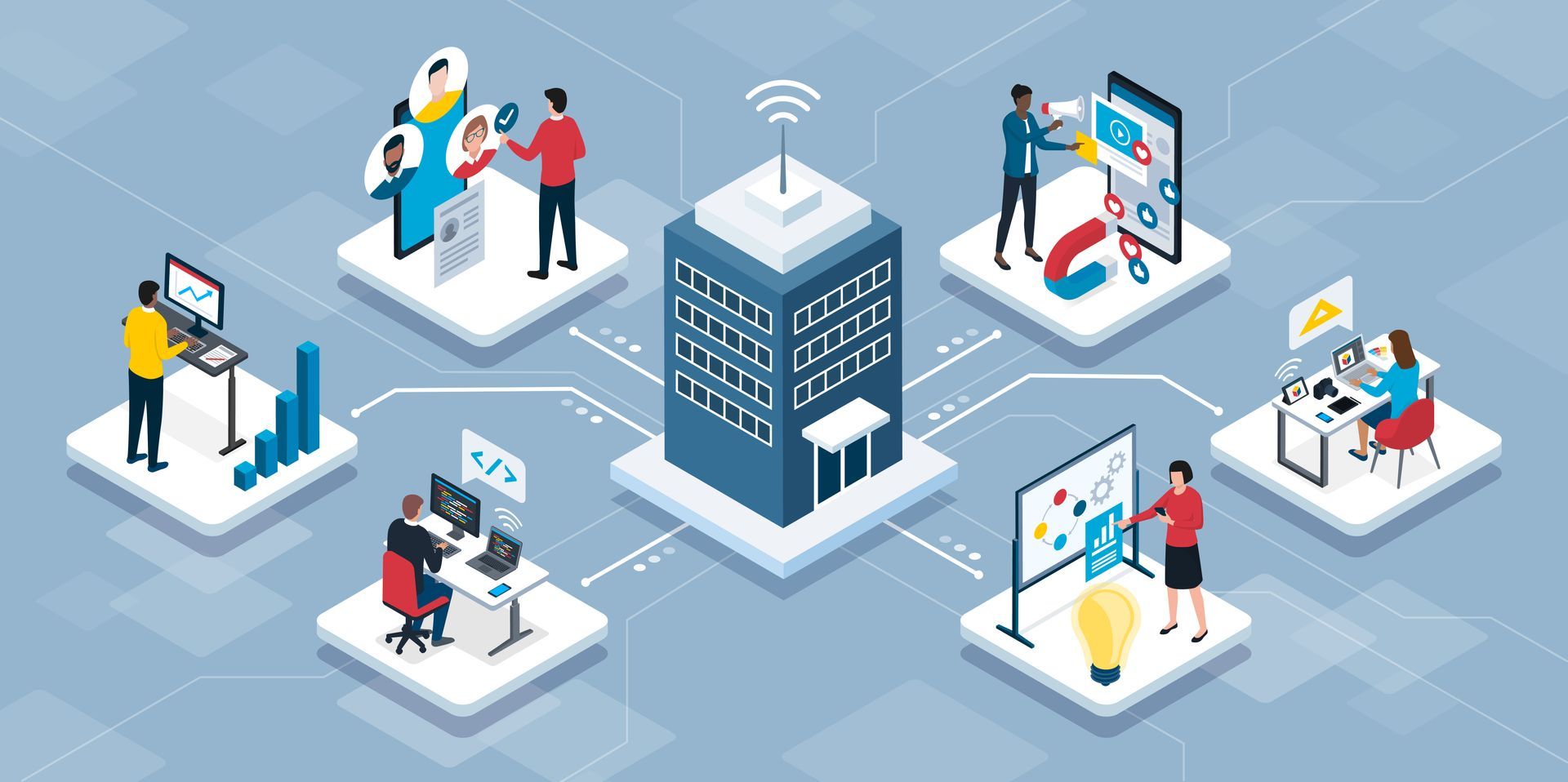Unlock Incredible Efficiency Gains with These 7 IT Infrastructure Upgrades
Let's get to the point: your IT infrastructure is crucial. It's not merely a part of your business; it's what keeps everything running smoothly.
An outdated system isn't just a minor inconvenience; it's a barrier to your business's success. But there's a silver lining. Upgrading your IT infrastructure can lead to significant efficiency gains, not to mention the peace of mind that comes with reliability and speed. Let's explore how you can start enhancing your systems today with some straightforward, practical steps. Ready to dive in?
1. Upgrade to Cloud-Based Services
If there's one thing that's revolutionizing businesses today, it's cloud computing. Moving to the cloud isn't just a trend; it's a game-changer for storage, accessibility, and scalability. You're no longer shackled by physical servers or limited by storage space. Instead, you get flexibility and the ability to scale your resources according to demand.
But it's not just about convenience. Cloud services can significantly reduce your IT costs. You pay for what you use, say goodbye to expensive hardware maintenance, and streamline your operations. Plus, with the cloud, your team can collaborate and access files from anywhere, boosting productivity.
Choosing the right cloud service provider is crucial. Look for one that not only fits your budget but also aligns with your security requirements and business goals. And remember, migrating to the cloud should be a thoughtful process. Start small, perhaps with non-essential data, and gradually move more critical functions as you gain confidence and control.
2. Implement Robust Cybersecurity Measures
In today's digital age, cybersecurity is not optional; it's essential. As businesses become increasingly online, the risk of cyber threats also escalates. It's not just about protecting your data; it's about safeguarding your business's reputation and your customers' trust.
Start by updating or installing quality cybersecurity software that includes antivirus, anti-malware, and firewall protections. But don't stop there. Cybersecurity is an ongoing battle. Regularly update your systems to patch vulnerabilities as soon as they're discovered.
Employee education is another critical piece of the puzzle. Many breaches occur due to human error, so ensure your team knows how to recognize and respond to potential threats, like phishing emails.
Lastly, consider conducting regular security audits. These can help identify vulnerabilities in your network and recommend improvements. It might seem like a hassle, but believe me, it's worth it. The cost of preventing a breach is always less than the cost of recovering from one.
3. Optimize Network Performance
Your network is the highway of your IT infrastructure, and like any highway, traffic jams can slow down everything. If your network is lagging, so is your business’s potential. It's not just about speed; it's about smooth, uninterrupted access to data and applications that your team needs to perform efficiently.
First, assess your current network setup. Are there bottlenecks? Is your hardware outdated? Sometimes, a simple upgrade to faster routers or switches can make a significant difference. Other times, you might need to reconfigure your network layout for better performance.
Consider the potential of software-defined networking (SDN). SDN offers a more flexible approach to network management, allowing you to control traffic flow and prioritize business-critical applications dynamically. It’s like having a traffic cop that ensures your most important data gets through smoothly, without any hold-ups.
Also, don’t overlook your Wi-Fi. Poor Wi-Fi can be a productivity killer. Ensure your Wi-Fi network covers all areas adequately and supports the number of devices connected. Upgrading to the latest Wi-Fi standard can offer faster speeds and better performance.
Remember, a well-optimized network means a more efficient, productive business. Start by identifying your current issues, then take steps to streamline and enhance your network’s performance. It's an investment that pays off in speed, reliability, and satisfaction.
4. Streamline Data Management
Effective data management is key to efficiency. Start by cleaning up unnecessary data to improve storage and accessibility. Establish clear policies on data access and usage to ensure security and effectiveness.
Invest in a good data management tool to integrate, control, and analyze your data more effectively. Remember, regular backups are essential to prevent data loss, and a solid recovery plan is crucial for quick restoration after any mishaps.
Simplifying your data management not only boosts productivity but also supports better, data-driven decision-making.
5. Update Hardware Components
Outdated hardware can slow you down, leading to lost time and frustration. It's essential to assess and update your hardware regularly to maintain optimal performance and efficiency.
Evaluate your current hardware, such as computers, servers, and networking devices. Identify any components that are slowing your processes or could fail soon. Upgrading to solid-state drives (SSDs), adding more RAM, or replacing old servers can significantly boost your system's speed and reliability.
While upgrading, consider energy efficiency and longevity to get the most out of your investment. Also, responsibly recycle old hardware to minimize environmental impact.
Remember, up-to-date hardware supports smoother operations and can handle modern software demands, keeping your business competitive and agile.
6. Enhance Collaboration Tools
In today's hybrid work environment, effective collaboration tools are not just helpful; they're essential. They break down geographical barriers and foster a cohesive team dynamic, ensuring everyone, no matter where they are, stays connected and productive.
Review your current collaboration tools for communication, project management, and file sharing. Are they meeting your team’s needs? If there are gaps or frustrations, it's time for an upgrade. Look for platforms that integrate seamlessly, offer reliable support, and adapt to your team's workflow.
Upgrading to more sophisticated tools can lead to better teamwork, streamlined projects, and faster results. Choose solutions that are user-friendly and secure, supporting your team's best work while protecting your data.
In enhancing your collaboration tools, you're not just investing in software; you're investing in your team's synergy and success.
7. Regular IT Audits and Maintenance
Continuous improvement is key in maintaining an efficient IT infrastructure. Regular IT audits help identify areas that need attention, ensuring your technology aligns with your business goals and operates at peak efficiency.
Schedule periodic audits to examine the health and performance of your systems. Look for outdated software, underused resources, or security vulnerabilities. An audit can also reveal opportunities for optimization that you might have missed.
Along with audits, establish a routine maintenance schedule. Regular checks and updates can prevent small issues from turning into big problems. This includes updating software, replacing old hardware before it fails, and reviewing security protocols.
Implementing a regular audit and maintenance schedule helps keep your IT infrastructure reliable and secure, supporting your business’s continuous growth and adaptation to changing needs. Book Your FREE Audit Here
In Summary
Upgrading your IT infrastructure is not just a technical necessity; it's a strategic business move. By implementing these seven upgrades, you can unlock incredible efficiency gains, improve security, and foster a more collaborative and productive work environment.
Remember, the journey to a robust IT infrastructure doesn't end with these steps; it requires ongoing attention and adaptation to new technologies and business needs. Start with the areas that need the most urgent attention in your business and gradually build from there.
Don't wait for a system failure to be the wake-up call. Begin your upgrades today and set your business on a path to improved efficiency and success. If you're unsure where to start or need expert advice, consider reaching out for a professional IT assessment. Your future self will thank you for taking action now.




